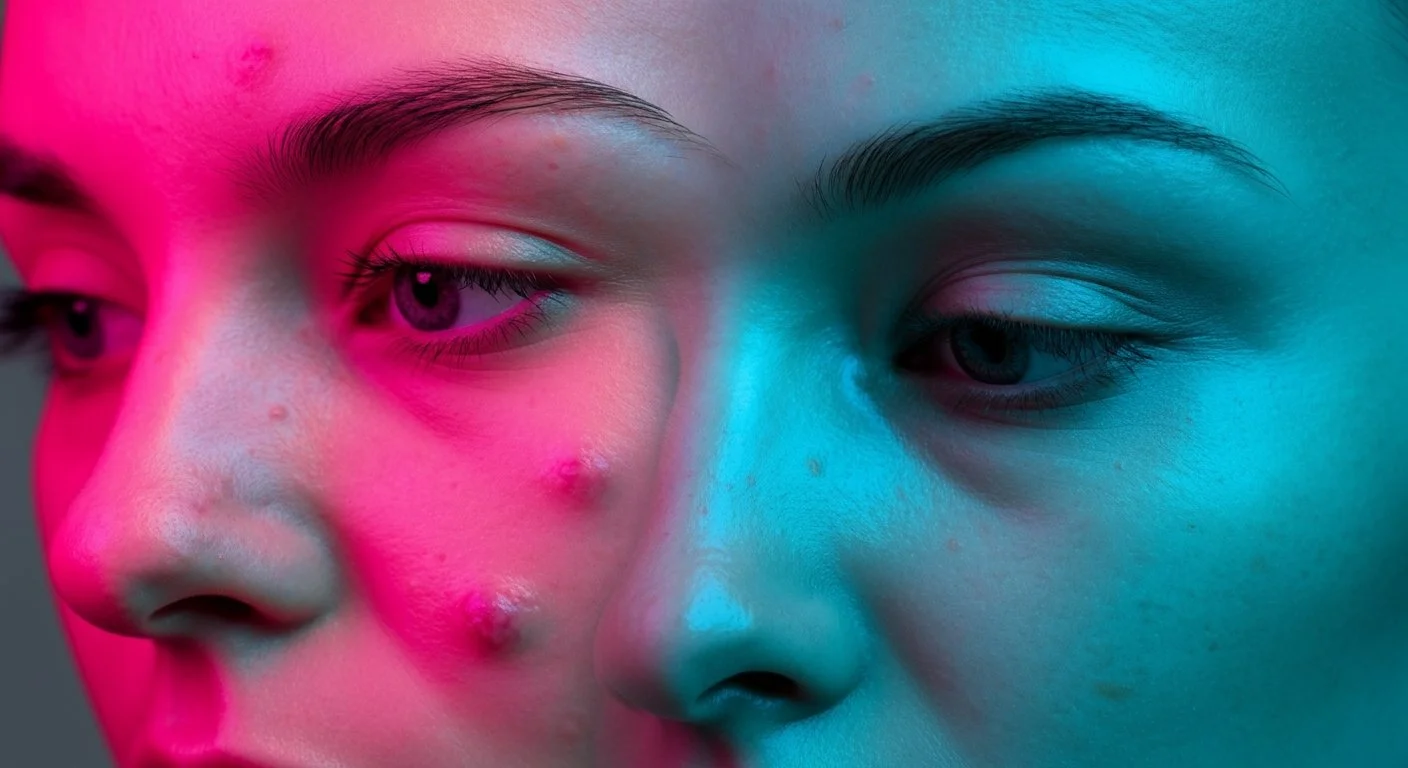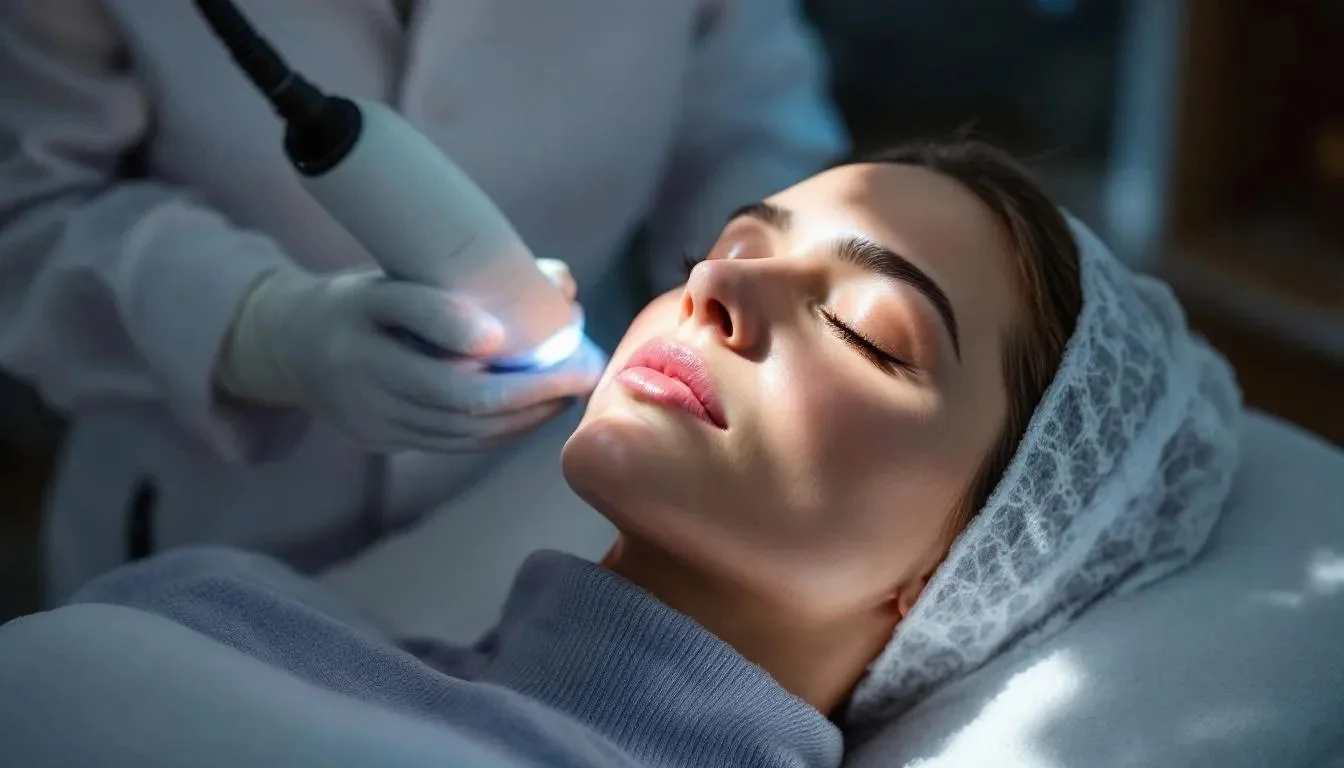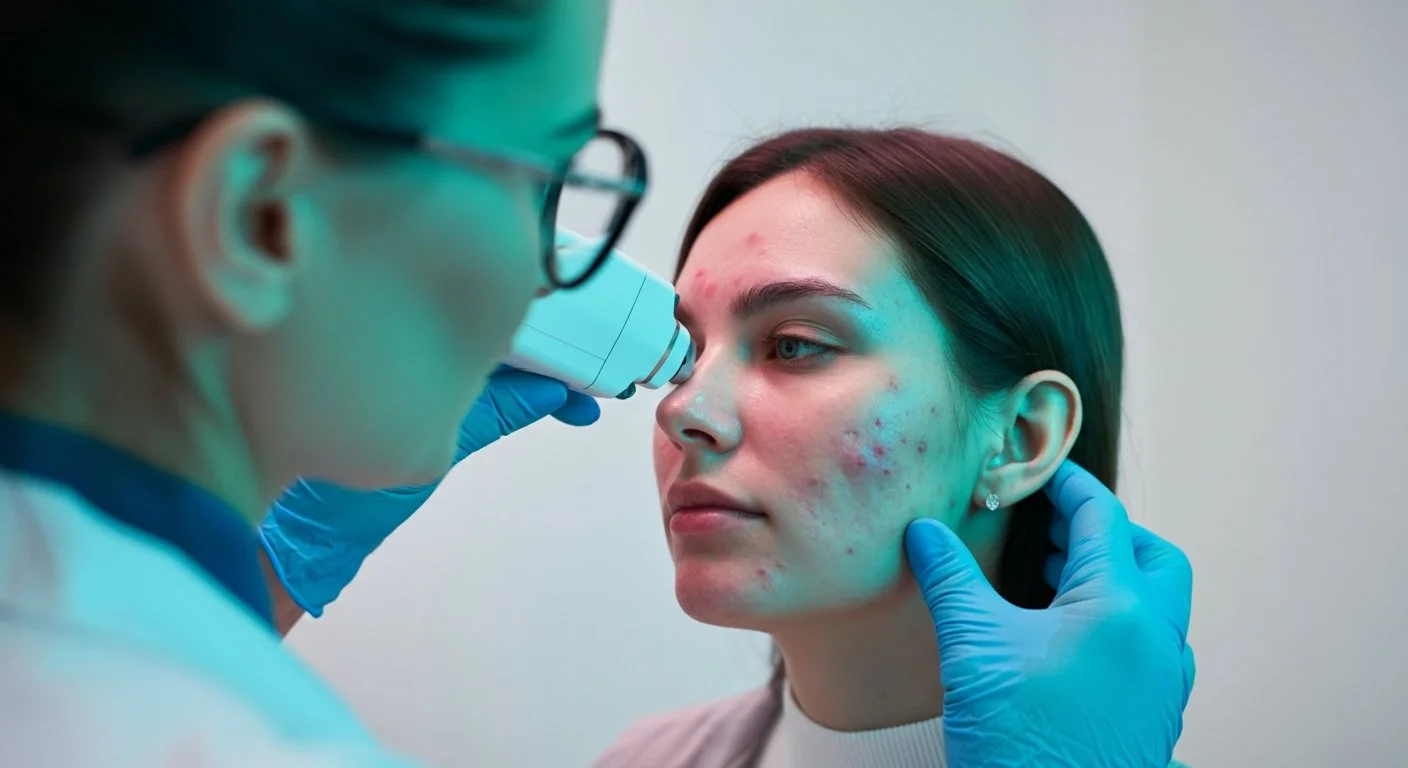Laser Cystic Acne Treatment: Your Complete Guide to Clearer Skin
If you're struggling with painful, stubborn cystic acne that doesn't respond to traditional treatments, you're probably feeling frustrated and desperate for a solution. Those deep, inflamed bumps under your skin aren't just physically uncomfortable—they can seriously impact your confidence and quality of life.
The good news? Laser cystic acne treatment has emerged as a game-changing option for people dealing with severe acne. Unlike topical creams or oral medications that can take months to work (if they work at all), laser therapy targets acne at its source, reducing inflammation, killing acne-causing bacteria, and helping prevent future breakouts.
At Advanced Dermatology & Aesthetic Medicine in Chicago, board-certified dermatologists Dr. Monica Rani and Dr. Stavonnie Patterson use advanced laser technology to help patients finally achieve the clear skin they've been searching for. With over 15 years of combined experience and FDA-cleared equipment, they've developed treatment protocols that deliver real results for even the most stubborn cystic acne.
Quick Answer: Laser cystic acne treatment uses targeted light energy to penetrate deep into the skin, reducing inflammation, killing acne-causing bacteria, decreasing oil production, and promoting healing. The FDA-cleared Aerolase laser is particularly effective, showing reduction in acne lesions, redness, and oiliness with the first treatment, with optimal results achieved after 4-6 sessions spaced 2-4 weeks apart.
What is Cystic Acne and Why Is It So Difficult to Treat?
Before diving into laser treatment options, it's important to understand what makes cystic acne different from typical breakouts.
Understanding Cystic Acne
Cystic acne is the most severe form of acne. Unlike whiteheads or blackheads that form on the skin's surface, cystic acne develops deep within the skin when pores become blocked, leading to infection and inflammation.
These deep, painful lumps feel like soft, fluid-filled nodules beneath your skin. They're often tender to the touch and can last for weeks or even months. When they finally heal, they frequently leave behind dark spots or permanent scarring—which is why early, effective treatment is so crucial.
Cystic acne typically appears on the face, jawline, neck, chest, back, and shoulders. It's more common during teenage years and in women due to hormonal fluctuations, but it can affect anyone at any age.
Why Traditional Treatments Often Fall Short
Many people with cystic acne have already tried countless over-the-counter products, prescription topical treatments, and oral medications with limited success. Here's why traditional approaches struggle with cystic acne:
Surface treatments can't reach deep enough. Since cystic acne forms far below the skin's surface, topical creams and gels often can't penetrate deeply enough to make a real difference.
Oral medications come with side effects. Antibiotics and isotretinoin (Accutane) can be effective but may cause significant side effects, and many people can't or don't want to take them long-term.
Hormonal treatments have limitations. While birth control or spironolactone can help hormonal acne, they don't work for everyone and require ongoing use.
This is where laser cystic acne treatment offers a breakthrough alternative.
How Laser Treatment Works for Cystic Acne
Laser therapy for cystic acne isn't just one approach—it's a sophisticated technology that targets multiple factors causing severe breakouts.
The Science Behind Laser Acne Treatment
Laser treatments use focused light energy at specific wavelengths to penetrate the skin at various depths. When used for cystic acne treatment, lasers work through several mechanisms simultaneously:
Targeting bacteria: The light energy heats and destroys Propionibacterium acnes (P. acnes), the bacteria responsible for acne inflammation. By reducing bacterial populations in the skin, laser treatment helps prevent new breakouts from forming.
Reducing inflammation: Laser energy helps calm the inflammatory response that makes cystic acne so painful and visible. This leads to faster healing of existing breakouts and reduced redness.
Decreasing oil production: Certain laser wavelengths can target overactive sebaceous glands, temporarily reducing excess oil production that contributes to clogged pores and acne formation.
Promoting healing: Laser treatment stimulates collagen production and cellular turnover, helping your skin heal faster and reducing the risk of permanent scarring.
The Aerolase Laser: FDA-Cleared Technology
At Advanced Dermatology & Aesthetic Medicine, we use the Aerolase laser, which is specifically FDA-cleared for acne treatment. This advanced technology offers several advantages over other laser systems.
The Aerolase uses a 1064nm wavelength that targets water, melanin, and hemoglobin in the skin. This deep penetration allows the laser to effectively treat acne at its source while also improving overall skin tone and texture.
What makes the Aerolase particularly special? It's safe and effective for all skin tones. Many laser treatments carry a higher risk of hyperpigmentation or discoloration in darker skin, but the Aerolase is specifically designed to minimize these risks. This makes it an excellent option for patients of all ethnic backgrounds.
Clinical studies show impressive results: reduction in acne lesions visible even after the first treatment, decreased redness and inflammation, less oily skin and smaller pores, and improvement in overall skin texture and tone.
What to Expect During Treatment
Laser cystic acne treatment is surprisingly comfortable and convenient. Here's what a typical session looks like:
Your dermatologist will cleanse your skin thoroughly to remove any makeup, oil, or debris. You'll wear protective eyewear during the treatment to shield your eyes from the laser light.
The laser handpiece is moved across treatment areas in a systematic pattern. Most patients describe the sensation as a warm, snapping feeling—tolerable and not particularly painful. Unlike some lasers that require numbing cream, the Aerolase's built-in cooling system keeps treatment comfortable.
Each session typically takes 15-30 minutes depending on the treatment area size. There's no downtime, meaning you can immediately return to your normal activities—including wearing makeup if desired.
Treatment Protocol and Expected Results
One of the most common questions patients ask is, "How many treatments will I need, and when will I see results?"
Typical Treatment Schedule
For optimal results with laser cystic acne treatment, most patients require 4-6 treatment sessions. These are typically spaced 2-4 weeks apart to allow your skin to respond and heal between treatments.
Your dermatologist will customize the exact protocol based on your acne severity, how your skin responds to initial treatments, your skin type and tone, and whether you're combining laser therapy with other treatments.
Some patients with milder cystic acne may see significant improvement with just 2-3 sessions, while those with severe, long-standing acne might benefit from additional treatments.
Timeline for Results
Here's what you can realistically expect:
After the first treatment: Many patients notice their skin looks calmer and less inflamed almost immediately. Active breakouts may start healing faster, and you might notice reduced oiliness within a few days.
After 2-3 treatments: You should see a noticeable reduction in new breakouts. Existing cystic lesions heal more quickly, and your skin's overall texture begins improving.
After 4-6 treatments: Most patients achieve significant clearing of cystic acne. While you may still get occasional breakouts (especially around hormonal cycles), they're typically much less severe and heal faster.
Long-term results: Many patients enjoy extended periods of clear skin after completing their treatment series. Maintenance sessions every few months can help sustain results, especially if you're prone to hormonal breakouts.
Factors That Influence Success
Several factors affect how well laser treatment works for your cystic acne:
Underlying causes: If hormonal imbalances or other medical conditions contribute to your acne, addressing these factors alongside laser treatment improves outcomes.
Skincare compliance: Following your dermatologist's home care recommendations—including gentle cleansing, appropriate moisturizing, and avoiding pore-clogging products—significantly impacts results.
Lifestyle factors: Diet, stress levels, sleep quality, and other lifestyle elements can influence acne. While laser treatment is powerful, a holistic approach yields the best long-term results.
Combining Laser Treatment with Comprehensive Acne Care
The most effective approach to cystic acne typically combines laser therapy with other treatments and proper skincare.
Medical-Grade Skincare for Acne-Prone Skin
Supporting your laser treatments with the right skincare products accelerates healing and helps prevent future breakouts.
The ADAM Alpha Beta Pads are specifically formulated for acne treatment. These cleansing pads contain glycolic acid (5%) and salicylic acid (2%)—a powerful combination that exfoliates dead skin cells, unclogs pores, and reduces inflammation. They're particularly effective for mild to moderate acne and can be used daily after cleansing.
For moisturizing acne-prone skin without clogging pores, the ADAM Ultra Lite Hydration is ideal. This lightweight moisturizer uses aloe vera and high-performance hydrators to replenish and rebalance skin without adding excess oil. Proper hydration is crucial—even oily, acne-prone skin needs moisture to heal properly.
After your laser treatments, your skin may be more sensitive. The ADAM Biocell Repair Moisturizer provides intensive support with ceramides, peptides, and antioxidants that help repair your skin barrier and promote healing.
Additional Professional Treatments
Your dermatologist might recommend combining laser therapy with other treatments for optimal results:
Chemical peels can help exfoliate the skin surface, unclog pores, and improve the penetration of topical treatments. When combined with laser therapy, peels can enhance overall results.
Extractions performed by a trained medical esthetician can safely remove stubborn comedones and help accelerate healing.
Prescription medications such as topical retinoids, antibiotics, or hormonal treatments may be recommended alongside laser therapy, especially for severe cases.
Laser Treatment Safety and Side Effects
One of the biggest advantages of laser cystic acne treatment is its excellent safety profile when performed by qualified dermatologists.
What to Expect After Treatment
Most patients experience minimal side effects. You might notice mild redness immediately after treatment, similar to a mild sunburn. This typically fades within a few hours to a day.
Some patients experience temporary dryness or slight flaking as the skin heals and renews itself. This is actually a positive sign that the treatment is working. Using a gentle moisturizer like ADAM Ultra Lite Hydration helps manage any dryness.
Occasionally, existing breakouts may look slightly worse before improving—this is called "purging" and indicates that the treatment is bringing underlying congestion to the surface more quickly.
Important Safety Considerations
While laser treatment is safe, certain precautions are essential:
Avoid sun exposure and tanning. Your skin is more sensitive after laser treatment, and UV exposure increases the risk of side effects. Always wear broad-spectrum SPF 30+ sunscreen, even on cloudy days.
Skip retinoids before treatment. If you use topical retinoids or other potentially sensitizing products, your dermatologist may ask you to pause them before and after laser sessions.
Disclose all medications. Some medications increase photosensitivity. Always tell your dermatologist about everything you're taking, including supplements and over-the-counter medications.
Choose experienced providers. The skill and experience of your dermatologist significantly impacts both safety and results. Board-certified dermatologists like Dr. Rani and Dr. Patterson have the expertise to customize treatment settings for your specific skin type and acne severity.
Who Is a Good Candidate for Laser Cystic Acne Treatment?
Laser therapy works well for many people with cystic acne, but it's not necessarily the right choice for everyone.
Ideal Candidates Include
People with moderate to severe cystic acne that hasn't responded adequately to traditional treatments like topical medications or oral antibiotics.
Those who can't tolerate or prefer to avoid oral medications like isotretinoin due to side effects or personal preference.
Anyone looking for a treatment with minimal downtime who needs to maintain their regular schedule without lengthy recovery periods.
Patients of all skin tones, especially those concerned about hyperpigmentation risk with other treatments.
When Other Treatments May Be Better
If you have mild acne with mostly surface-level whiteheads and blackheads, you might see excellent results with simpler, less expensive treatments like topical retinoids or chemical peels.
If active skin infections, severe eczema, or certain other skin conditions are present, these typically need to be addressed before laser treatment.
Pregnant or breastfeeding women should discuss timing with their dermatologist, as some treatments may be delayed until after this period.
Cost Considerations and Insurance Coverage
Understanding the financial investment helps you plan appropriately for laser cystic acne treatment.
Treatment Costs
The cost of laser acne treatment varies based on treatment area size (full face vs. targeted zones), number of sessions needed (typically 4-6 for optimal results), geographic location and practice type, and whether you're combining laser with other treatments.
Single laser acne treatment sessions typically range from $300-$600. A complete treatment series of 4-6 sessions might cost $1,500-$3,000 or more. Many practices offer package pricing that reduces the per-session cost.
Insurance and Payment Options
Unfortunately, laser acne treatment is typically considered cosmetic and isn't covered by health insurance, even though cystic acne is a medical condition. However, some practices offer payment plans or financing options to make treatment more accessible.
If you have a Health Savings Account (HSA) or Flexible Spending Account (FSA), you may be able to use these funds for acne treatment. Check with your plan administrator about coverage.
Maintaining Your Results After Laser Treatment
Achieving clear skin is wonderful, but maintaining those results requires ongoing care.
Long-Term Skincare Strategy
Continue using appropriate skincare products even after your acne clears. The ADAM skincare line provides dermatologist-formulated options to maintain clear, healthy skin long-term.
Never skip sunscreen. UV exposure can trigger inflammation and worsen acne, plus it's essential for preventing hyperpigmentation and early aging.
Work with your dermatologist to adjust your skincare routine as your needs change with seasons, age, and hormonal fluctuations.
Maintenance Treatments
Some patients benefit from periodic maintenance laser sessions—perhaps quarterly or twice yearly—to keep acne under control. This is especially helpful if you're prone to hormonal breakouts or seasonal flare-ups.
Regular follow-up appointments with your dermatologist ensure any new issues are caught and addressed early, before they become severe.
Frequently Asked Questions
How painful is laser treatment for cystic acne?
Most patients find laser acne treatment quite tolerable. The Aerolase laser includes a cooling system that makes treatment comfortable—many describe it as feeling like warm snaps or light tingling on the skin. It's generally much less uncomfortable than you might expect, and no numbing cream is needed. The treatment is quick (15-30 minutes), making any minor discomfort very brief. If you're concerned about sensitivity, discuss this with your dermatologist before treatment.
Can laser treatment completely cure cystic acne?
While laser treatment is highly effective, it's important to have realistic expectations. Laser therapy can dramatically reduce acne severity, prevent new breakouts, and help keep your skin clear for extended periods. However, if underlying factors like hormones, genetics, or lifestyle continue triggering acne, you may need occasional maintenance treatments. Many patients achieve long-term control with initial treatment series followed by periodic maintenance sessions. Think of it as managing a chronic condition rather than a one-time cure.
Is laser acne treatment safe for dark skin tones?
Yes! This is one of the major advantages of the Aerolase laser used at Advanced Dermatology. It's specifically FDA-cleared for all skin tones and has a lower risk of causing hyperpigmentation compared to other laser types. Many traditional acne lasers carry higher risks for darker skin, but the Aerolase's specific wavelength (1064nm) and cooling technology make it safe and effective regardless of your skin color. Dr. Rani and Dr. Patterson have extensive experience treating patients of all ethnic backgrounds safely.
How soon can I wear makeup after laser treatment?
One of the benefits of laser cystic acne treatment is zero downtime. You can apply makeup immediately after treatment if needed. However, many dermatologists recommend giving your skin a few hours to breathe if possible, especially after your first treatment. Use non-comedogenic (non-pore-clogging) makeup products, and always remove makeup thoroughly before bed. If your skin feels sensitive, consider skipping makeup for 24 hours to allow optimal healing.
Will laser treatment help with acne scars too?
Laser treatment for active acne provides some improvement in skin texture and mild scarring as a bonus benefit. However, significant acne scars typically require different laser treatments specifically designed for acne scar removal. The good news is that getting your active acne under control first prevents new scars from forming. Once your breakouts are managed, your dermatologist can recommend appropriate treatments for any existing scars, which might include fractional lasers, microneedling with PRP, or other resurfacing techniques.
Take Control of Your Cystic Acne Today
Living with painful, stubborn cystic acne doesn't have to be your reality. Laser treatment offers a scientifically proven, safe, and effective solution that targets acne at its source—reducing inflammation, killing bacteria, and helping you achieve the clear skin you deserve.
At Advanced Dermatology & Aesthetic Medicine in Chicago's South Loop, board-certified dermatologists Dr. Monica Rani and Dr. Stavonnie Patterson combine cutting-edge FDA-cleared laser technology with personalized care to deliver exceptional results. Their comprehensive approach doesn't just treat your acne—it addresses your unique skin concerns, lifestyle, and goals to create a customized treatment plan that works for you.
Why choose Advanced Dermatology for your laser cystic acne treatment? Board-certified dermatologists with over 15 years of combined experience, FDA-cleared Aerolase laser safe for all skin tones, proven results with reduction in lesions visible after just one treatment, minimal to no downtime so you can maintain your schedule, comprehensive care including medical-grade ADAM skincare products, convenient South Loop Chicago location with flexible appointment scheduling, and personalized treatment plans tailored to your specific needs.
Ready to finally get your cystic acne under control? Your journey to clearer, healthier, more confident skin starts with a comprehensive consultation. During your visit, you'll receive a thorough skin analysis and acne severity assessment, discussion of laser treatment benefits and what to expect, customized treatment plan with timeline and cost transparency, and answers to all your questions about laser acne therapy.
Don't let cystic acne hold you back any longer. Call (847) 802-9667 or schedule your consultation online today. The expert team at Advanced Dermatology & Aesthetic Medicine is ready to help you achieve the clear, beautiful skin you've been dreaming about. New patients are always welcome!




